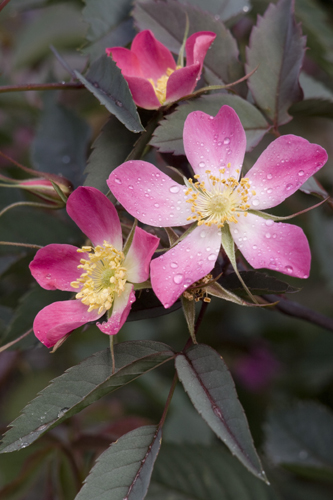Rosa glauca
single pink species rose


© Great Plant Picks

© Richie Steffen / Great Plant Picks
© Richie Steffen / Great Plant Picks
Outstanding Qualities
This species rose features glaucous purplish gray-green foliage resistant to black spot. Small clusters of single pink flowers with gold centers cover this deciduous shrub in late spring and early summer. In autumn, scarlet hips provide late season interest in addition to attracting wildlife.This handsome rose, grown for its blue-purple leaves, should be included in every garden. Grow it with Geranium himalayense 'Baby Blue', Helictotrichon sempervirens, Aster lateriflorus 'Prince', Allium christophii, and Diascia vigilis 'Jack Elliott' for a grouping that is attractive in spring, summer, and fall.
Quick Facts
Plant Type: shrub
Foliage Type: deciduous
Plant Height (10-year): 5 ft. 0 in. (1.52 meters)
Plant Width/Spread (10-year): 6 ft. 0 in. (1.83 meters)
Plant Height-Mature: 8 ft. 0 in. (2.44 meters)
Plant Width-Mature: 9 ft. 0 in. (2.74 meters)
Hardiness: USDA Zones 6 to 9
Flower Color: pink
Flowering Time: spring
Sun/Light Exposure: full sun
Water Requirements: drought tolerant when established, but appreciates occasional watering
Seasonal Interest: distinctive foliage spring through fall, pink flowers in summer
Wildlife Associations: bees
Culture Notes
This tough shrub rose thrives in well-drained or sandy soil. Once established it is drought tolerant, but it appreciates occasional watering during dry weather. The most vigorous growth is in full sun. The small flowers are pleasant, but the foliage is beautiful and showy. This rose can be pruned to the ground every two to three years to encourage robust tall canes with the best foliage. It has excellent disease resistance. Pruning can be done in early spring.
Geek Notes
synonym Rosa rubrifolia. medium pink. single. thornless. intro 1789.
Text and photos ©2025 Great Plant Picks/Elisabeth Carey Miller Garden except where otherwise noted
Funded by the Pendleton and Elisabeth Carey Miller Charitable Foundation, The Seattle Times, and Individual Donors
Administered by the Elisabeth Carey Miller Botanical Garden

